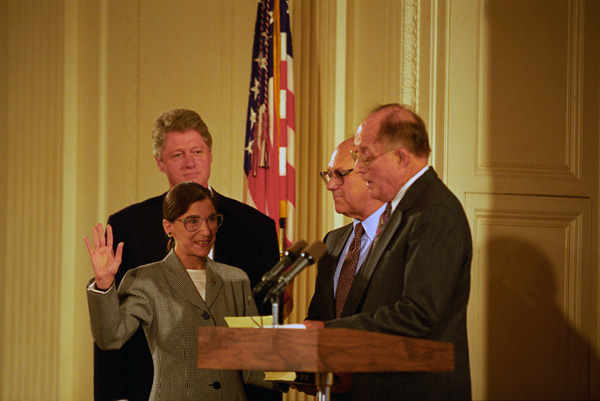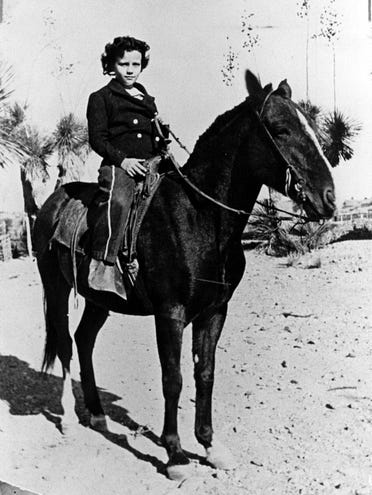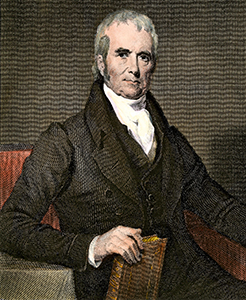Pop Civ 4: A Tale of Two Justices
Introduction
As we welcome Women’s History Month, we’re taking a look at the relationship between two trailblazing women, our nation’s first and second female justices on the Supreme Court, Sandra Day O’Connor and Ruth Bader Ginsburg.
Supreme court before 1981 (no women)
From its inception in 1789 until the arrival of Sandra Day O’Connor in 1981, America’s highest court was an exclusively male institution. While the 20th century saw women make their way onto the bench in courtrooms across the nation, by 1980, only 17 percent of American judges were female. President Ronald Reagan’s decision to nominate O’Connor to the position of Associate Justice helped make way for a new era on the Court.
Sandra Day O’Connor
Born in 1930, Justice O’Connor began her life as Sandra Day, a daughter of ranchers who lived in the Southwest. A precocious student, she entered Stanford University at the age of 16 to pursue an undergraduate degree in economics, graduating Magna Cum Laude in 1950. She resumed her studies at Stanford in 1952 to pursue a law degree, where she served on the Stanford Law Review (with, coincidentally, her future Chief Justice, William Rehnquist) and was a member of the Order of the Coif, a title indicating her position as part of the top ten percent of her class.
After her graduation in 1952, Day married John Jay O’Connor III, a fellow Stanford alum. Because of her gender, O’Connor struggled to find a place for herself in a traditional law practice. She worked for a period of time without pay as a deputy county attorney in San Mateo, CA, but eventually drew a salary after several months in the role.
After traveling to a military assignment in Germany, the O’Connors settled in Arizona, where Sandra began work volunteering for political campaigns in the state. O’Connor went on to serve as Arizona Assistant Attorney General from 1965-69 and was named to the state’s legislature in 1969. By 1973, she had become the nation’s first female State Senate Majority Leader. In 1974, O’Connor was elected to the Maricopa County Superior Court and was elevated to the Arizona Court of Appeals in 1979.
History was made when President Reagan nominated O’Connor to the Supreme Court in 1981, fulfilling his campaign promise to put a woman on the highest court of the land. While many welcomed the idea of having a female justice, right-wing groups were concerned that O’Connor, who had gained a reputation in Arizona as a moderate, would not be conservative enough. The issue of abortion loomed large in her Senate Judiciary Committee confirmation hearing, the first ever of its kind to be televised. Eventually, the Senate confirmed O’Connor with a vote of 99-0.
O’Connor proved to be the strong moderate many supposed she would be. While she tended to vote more conservatively early in her tenure (often siding with Chief Justice and former classmate Rehnquist), as the makeup of the court shifted towards the right, her vote shifted towards the middle, and O’Connor frequently was the swing vote in Court decisions.
Original Caption: Photograph of Sandra Day O’Connor Being Sworn in a Supreme Court Justice by Chief Justice Warren Burger, Her Husband John O’Connor Looks On, 09/25/1981
Ruth Bader Ginsburg
Joan Ruth Bader was born in 1933 in Brooklyn, NY, to a Polish-Ukranian Jewish family living in the Flatbush neighborhood. Spurred by her mother’s eager hopes that her daughter would go further with her education than she herself had, Ruth was an avid student and entered Cornell University at age 17. There she met her future husband, Martin Ginsburg, and went on to be the highest-ranking graduate of the Class of 1954. After their graduation, the Ginsburgs relocated to Oklahoma, where Martin was stationed in the U.S. Army Reserves. There, Ruth worked for the Social Security Administration but was demoted when her supervisors learned she was pregnant with her first child.
In 1956, Ginsburg enrolled in Harvard Law School, where the gender gap was starkly evident. Only one of nine women in a class of 500, Ginsburg and her female classmates were reportedly asked by the Dean of the School why they were at Harvard Law, taking the place of men. Ginsburg would wind up transferring to Columbia Law School following her husband’s move to a new job, and would become the first woman to serve on two major law reviews (Harvard Law Review and Cornell Law Review).
Like O’Connor, Ginsburg struggled to find paid positions in the legal profession following her graduation in 1959. Despite tying for first in her class, she was rejected for a clerkship under Supreme Court Justice Felix Frankfurter because of her gender. Instead, she clerked under Edmund L. Palmieri, U.S. District Court Judge for the Southern District of New York. After two years in that position, Ginsburg began her shift back to academia, working at the Columbia Law School Project as an associate director. In 1963, she accepted a position as a professor at Rutgers Law School on the condition that she would be willing to accept a lower salary than her male counterparts. The School’s reasoning was that her husband was well paid in his job. Ginsburg earned tenure in 1969 and continued at Rutgers until 1972.
That same year, Ginsburg shifted away from academia as she helped to establish the Women’s Rights Project at the American Civil Liberties Union. In 1973, she assumed the role of the Project’s General Counsel, which included arguing gender discrimination cases in front of the Supreme Court, winning five out of the six cases she presented.
Ginsburg continued her work in advocacy for the next seven years, contributing substantially to the way women were treated by the law. In 1980, Ginsburg was nominated to the Court of Appeals for the Second Circuit by President Jimmy Carter. In that role, she was known for being a moderate jurist and often sided with her future Supreme Court colleague Antonin Scalia.
In 1993, President Bill Clinton nominated Ginsburg as an Associate Justice of the Supreme Court, based on recommendations from his Attorney General, Janet Reno, and Republican Senator Orrin Hatch. Ginsburg would be the second female and first Jewish justice and was expected by many to be a moderate influence on the court.
After her confirmation by the Senate (a 96-3 vote), Ginsburg took her place on the Court alongside Sandra Day O’Connor. Ginsburg’s tenure was characterized by her cautious approach to evaluating cases. She soon became a key player in the Court’s liberal wing and became that bloc’s most senior member after the retirement of Justice John Paul Stevens in 2010.
Chief Justice William Rehnquist swearing in Ruth Bader Ginsburg as an Associate Justice of the Supreme Court while President Bill Clinton and her husband, Martin Ginsburg, look on, 8/10/1993. (National Archives Identifier 3144719)
Relationship between Justices
While Ginsburg and O’Connor were not necessarily ideologically similar in their political views or in their decisions on the Court, their experiences as women in the legal profession helped them better understand each other and maintain a collegial relationship throughout their shared time on the bench.
One area where the two justices aligned were in rights for women. For example, in 1996, the Court heard United States v. Virginia, a case which asked the court to decide whether the male-only admission policy at Virginia Military Institute violated the constitutional rights of women. The majority had decided that the policy was, in fact, unconstitutional, but rather than write the opinion herself, as was the tradition for the senior member of the majority to do, O’Connor decided to give that task to Ginsburg. When Ginsburg announced the Court’s decision, she made a point of looking down the bench at her colleague as she cited O’Connor’s own opinion from 14 years earlier that ended sex-segregated admission policies in state schools.
When reflecting on the years they spent together on the Court, O’Connor and Ginsburg held each other in high regard. Whether or not they agreed on decisions being made in the Court itself, both women felt bolstered by the other’s presence as they navigated an environment that had never envisioned women among its ranks. From having to encourage the Court to build a women’s restroom to welcome Justice Ginsburg in 1993 (up until then, there had been no ladies’ room in the building) to finding a way to express sartorial flair through lace jabots or collars (a female complement to the male neckties the black robes were designed to display), to collaborating on decisions that validated women’s rights under the Constitution, Justices O’Connor and Ginsburg provided support for one another as they worked their way into history.
Supreme Court Justices
Sandra at the Ranch
Long before she became a world-renowned legal mind, young Sandra Day spent her time working on her family’s ranch in Arizona. Life on the Day ranch was spartan, without running water or electricity, and Sandra was tasked with all types of jobs to help the family. No shrinking violet, she was a crack shot with her .22-caliber rifle and often recounted shooting rabbits for her family’s supper. While her education quickly took her away from the rough and tumble life she enjoyed on the family ranch, O’Connor often cites her early years as key in helping develop the grit and determination she would use to pave her way through the male-dominated legal field.
Sandra Day O’Connor, seen here circa 1940, would grow up to be the first woman to serve on the U.S. Supreme Court. She had a rough-and-tumble childhood in southeastern Arizona and New Mexico. She spent a lot of time on horseback at her family’s ranch near Duncan, Arizona.
Special for The Republic
Ruth at the Opera
While the somber black robes worn by Supreme Court justices (and instituted by John Marshall) confer an air of seriousness to the individuals who wear them, Ruth Bader Ginsburg was someone who enjoyed a variety of non-legal pastimes. One of her favorite passions was a love of opera, which she shared with her Supreme Court colleague Antonin Scalia. In fact the two were even the subject of a comedic opera, Scalia/Ginsburg, by Derek Wang. After developing a love of music in her youth, thanks to piano and cello lessons, Ginsburg fell in love with opera after hearing a condensed version of La Giaconda at a high school performance in 1944. She went on to have a walk-on role in performances of Die Fledermaus and Ariadne auf Naxos, and even debuted in a speaking role (for one night only) in The Daughter of the Regiment, all at the Washington National Opera.
Female justices in the Court today
After Sandra Day O’Connor’s retirement from the Court in 2006, Ginsburg remained the lone female justice on the bench until the appointment of Sonia Sotomoyor in 2009 by President Barack Obama. Elena Kagan joined them in 2010, also appointed by Obama, and the court continued with those three female justices until Ginsburg’s death in 2020. That same year, President Trump appointed Amy Coney Barrett as Associate Justice, and as of today, the Court’s makeup is still only a third female.
The first female supreme court justice, Sandra Day O’Connor (R), speaks as fellow Justice Ruth Bader Ginsburg listens during a forum at the Newseum, in Washington, DC, April 11, 2012, to mark the 30th anniversary of O’Connor’s first term on the Supreme Court. REUTERS / Mike Theiler – stock.adobe.com














